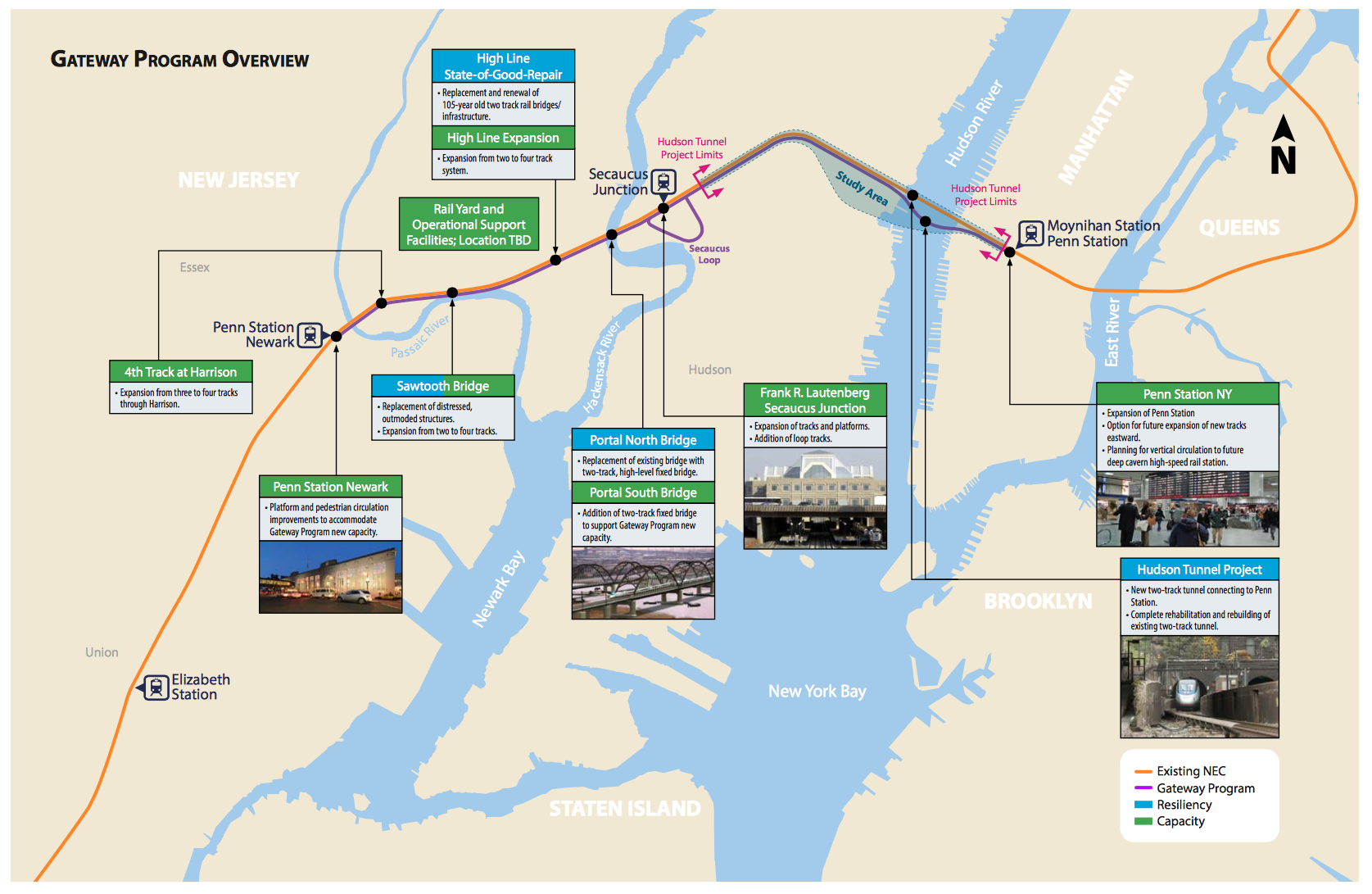June 30, 2017
Last week’s House hearing on passenger rail programs included testimony on the Gateway Program, a $24+ billion portfolio of rail projects in New York and New Jersey that would support both Amtrak and regional commuter rail and mass transit systems.
 The centerpiece of the portfolio is a new rail tunnel under the Hudson River, at a cost which Amtrak informally estimated 18 months ago would be $7.7 billion but which could be well above that (a formal cost estimate won’t be available until the draft EIS on the preferred alternative is finished as early as sometime this summer). Some people, including project sponsors from time to time, have conflated the Hudson Tunnel Project with the Gateway Program, calling it the Gateway Tunnel.
The centerpiece of the portfolio is a new rail tunnel under the Hudson River, at a cost which Amtrak informally estimated 18 months ago would be $7.7 billion but which could be well above that (a formal cost estimate won’t be available until the draft EIS on the preferred alternative is finished as early as sometime this summer). Some people, including project sponsors from time to time, have conflated the Hudson Tunnel Project with the Gateway Program, calling it the Gateway Tunnel.
(Ed. Note added July 1: This confusion is evident on the Gateway Program Development Corporation’s website – the very first sentence on the welcome page confuses a program and a project; “The Gateway Program, one of the most urgent infrastructure projects in the country, is a comprehensive rail investment program…”)
Gateway is about much more than the tunnel itself – the second-biggest item in the portfolio is a massive redesign of Manhattan’s Penn Station, for example – all of which is about giving Amtrak increased capacity on the Northeast Corridor (capacity which could be used by commuter railroads as well).
But the new tunnel has always been the centerpiece. A timeline explains why:
- October 2010 – New Jersey Governor Chris Christie kills the $8.7 billion Access to the Region’s Core (ARC) tunnel project under the Hudson River between Secaucus Junction and a new station under 34th Street in Manhattan, a decision criticized by other local political leaders and eventually second-guessed by GAO.
- February 2011 – Amtrak’s FY 2012 budget request announces a new, $13.5 billion Northeast Corridor Gateway program: “It is intended to provide additional passenger rail capacity on the existing NEC route into and through Manhattan, and is needed to support Amtrak’s proposed Next Generation High Speed Rail program. This comprehensive program will reconstruct the railroad between Newark and Penn Station, expand the right of way from two to four tracks, build two new tunnels under the Hudson River, and develop Amtrak’s planned Moynihan Station on the site of the existing post office.”
- October 2014 – Amtrak announces that the damage from Almost-Hurricane Sandy will eventually require year-long closures of each of the two tubes of the existing North River Tunnel under the Hudson, necessitating the completion of a new tunnel before the repairs to the old tunnel can be made.
- September 2015 – After months of bickering, Governors Cuomo and Christie send President Obama a joint letter describing a new $20 billion Hudson River tunnel and stating “If the federal government will provide grants to pay for half of the cost of the project, the Port Authority, New York and New Jersey will take responsibility for developing a funding plan for the other half, convening all relevant agencies, and utilizing the proposed federal low-interest loan, local funding sources, and other funding strategies necessary to complement the federal grant commitment.”
- October 2015 – USDOT gives the North Portal Bridge project a $16 million TIGER grant.
- November 2015 – New York and New Jersey Governors and Senators issue a joint statement announcing that they had worked with USDOT and Amtrak and had “secured a commitment from both that their respective agencies would cover half of the total project costs. The federal share of funding for the project is likely to come from a combination of New Starts Grant dollars, Amtrak Northeast Corridor profits, Amtrak capital funds, annual appropriations, and other similar federal sources.” The agreement also calls for establishing a Gateway Development Corporation to pursue federal RRIF and TIFIA loans on behalf of New York and New Jersey.
- July 2016 – USDOT announces that both the Portal North Bridge and the Hudson Tunnel projects have been placed in the Project Development phase of the Federal Transit Administration’s Capital Investment Grant program (a.k.a. “new starts”) to allow the projects to begin incurring costs related to environmental review and engineering and design activities.
- September 2016 – Gateway partners submit a final funding rating package for the Portal North Bridge project to the Federal Transit Administration for approval, requesting FTA fund half of a $1.642 billion project. Project sponsors state, “If the project scores well, it will be included in the Department of Transportation’s recommendation for the President’s FY18 Budget.”
- November 2016 – The Gateway Program Development Corporation is formally established with a four-person Board of Trustees from New York, New Jersey, Amtrak and USDOT.
- December 2016 – Amtrak releases an economic benefit analysis of Gateway.
- January 2017 – The GPDC Board of Trustees holds its first meeting and approves a resolution authorizing the Corporation to request up to $6 billion in loans from USDOT. The Secretary of Transportation’s designee on the Board recuses himself.
- February 2017 – FTA gives the Portal North Bridge project a medium-high rating.
- March 2017 – President Trump’s discretionary budget blueprint calls for limiting FTA CIG program funding “to projects with existing full funding grant agreements only. Future investments in new transit projects would be funded by the localities that use and benefit from these localized projects.”
- May 2017 – The FTA submits its formal budget request for the CIG program for FY 2018 and it does not include the Portal North Bridge.
- June 2017 – The Gateway Corporation Board of Trustees authorizes a request for a $284 million RRIF loan for the Portal North Bridge project and authorizes the issuance of a Request for Information on the Hudson Tunnel Project. The Secretary of Transportation’s designee on the Board recuses himself from both votes.
It is obvious from the beginning of the timeline that the new Hudson River Tunnel project was conceived as a way around Governor Christie’s cancelation of the ARC tunnel project – instead of having Jersey Transit as the sponsor like ARC, the new tunnel would be under the aegis of Amtrak. But since Amtrak was now the lead, and since the new tunnel had to be different in some measurable way than the old tunnel, the new tunnel had to connect to NYC Penn Station. (The late Sen. Frank Lautenberg (D-NJ) was heavily involved in this, and the New Jersey terminus of the proposed new tunnel has already been named the Frank R. Lautenberg Station.)
But what was conceived as a long-range plan to expand Amtrak and commuter rail capacity became more time-sensitive after Sandy filled the existing twin tunnels (built in 1904 and 1908) with corrosive salt water.
Since the draft EIS on the new tunnel is not yet complete but the final EIS on the Portal North Bridge was completed nine years ago, it was the bridge that was proposed for the first funding for Gateway, not the much-more-time-sensitive tunnel.
Amtrak, New York and New Jersey are now in the uncomfortable position of trying to get the Trump Administration to fulfill a non-binding handshake deal from President Obama’s Secretary of Transportation promising to give federal grants for 50 percent of the cost of all of the projects in the Gateway portfolio, using programs like CIG and TIGER that the Trump Administration has proposed to eliminate.
In the short run, both the Portal North Bridge (for FY 2018) and the Hudson River Tunnel (for FY 2019 or 2020) are dependent on President Trump’s willingness to request funding for the projects – because unless the President requests a project, Senators can’t specifically fund the project without violating Congress’s self-imposed ban on earmarks.
In the long run, even if Congress keeps the CIG account going at the levels authorized by the FAST Act, there is nowhere near enough money in that account to pay for the Hudson tunnel (especially if it has to compete with future segments of the Second Avenue Subway on the other side of Manhattan).


 The centerpiece of the portfolio is a
The centerpiece of the portfolio is a 


